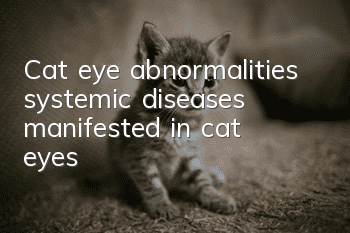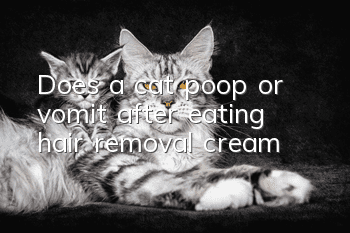Cat eye abnormalities, systemic diseases manifested in cat eyes!

The symptoms of some systemic diseases will appear in the eyes
The early symptoms of the disease will be reflected in a certain part, and for the cat’s eyes, it is also connected to the blood circulation and metabolism of the whole body. Some systemic diseases will start showing signs in the eyes, or some diseases will be infected from the eyes and slowly spread to the whole body. Typically, there are two types of diseases: infectious diseases and immune-mediated diseases. Cat eye abnormalities, systemic diseases manifested in cat eyes!
1. Infectious diseases
1. Tick-borne diseases
Infection with Rickettsia and Borrelia burgdorferi can cause conjunctivitis, subconjunctival hemorrhage, anterior uveitis, posterior uveitis, retinochoroiditis, retinal hemorrhage and optic neuritis. However, animals with eye lesions only account for 10 to 15% of the total sick animals.
Take conjunctivitis as an example. After a cat suffers from conjunctivitis, the affected eye will appear swollen, the conjunctiva will be flushed, the eyelids will be closed, and there will be bloody and purulent secretions. Kittens often have bloody and purulent secretions that glue their eyes together and make them unable to open their eyes. Acute catarrhal conjunctivitis, the secretion is thin or mucus; chronic catarrhal conjunctivitis, the secretion is very little, and the eye pain is not obvious; purulent conjunctivitis, the secretion is mucopurulent , the eyelids are often glued with blood and pus.
Optic neuritis in cats is also a common disease. The clinical manifestations are:
①Visual decline: Most of the vision suddenly declines, and even reduces to light perception or no light perception within a few days of onset. Light-sensitive.
②Drawing-like pain at the back of the eyeball when the eyeball is turned, and tenderness in the deep orbit.
③ Fundus changes: During papillitis, the optic disc is congested, slightly bulged (below 3D), the edges are unclear, the physiological depression disappears, the retinal veins are filled and tortuous, the retinal edema and turbidity around the optic papilla, and flame-like hemorrhage and yellowish white exudation. In acute retrobulbar optic neuritis, the fundus of the eye is basically normal in the early stage, but the color of the optic papilla becomes pale and the optic nerve atrophies in the late stage.
④Melan-100 glare test shows that under glare, red light and blue light, the pupillary reflex completely disappears, indicating optic nerve inflammation or optic chiasm tumor.
So when we find that our cat is bitten by a tick, we must do the following:
① When you find a tick staying on the skin, do not pull it hard to avoid tearing the tissue or damaging the skin. Secondary damage to the skin caused by broken mouthparts. You can apply chloroform, ether, kerosene, turpentine or dry smoke on the head of the tick and wait for the tick to fall naturally from the skin.
② Disinfect the wound. If the mouthparts is broken into the skin, surgery should be performed to remove it.
③ There is 0.5% procaine local seal around the wound.
④ Antihistamines and corticosteroids can be given when symptoms of systemic poisoning occur. When tick bite fever and tick paralysis are discovered, in addition to supportive therapy, corresponding symptomatic treatment and timely rescue are provided.
2. Histoplasmosis
Ocular lesions associated with this fungal disease include blepharitis, uveitis, retinochoroiditis, granulomatous retinal detachment, and optic neuritis.
For blepharitis in cats, the symptoms are:
① Tearing: It is caused by the stimulation of the trigeminal nerve, which causes the reflex hyperactivity of tear secretion, or the hypertrophy of the eyelids causes pressure on the tear points. ② Flushing and hypertrophy around the palpebral fissure.
③Blepharospasm.
④ Hair loss around the palpebral fissure, sometimes not visible in the acute stage.
⑤Chip falling.
⑥Scab formation.
When a fungal or parasitic infection is suspected, treat as for dermatomycosis, feline mange, and demodicosis.
Let’s talk about uveitis. Uveitis is the most common eye disease in cats and can often cause chronic pain in the eyeballs and even blindness. Feline uveitis is not just an eye disease, it is associated with many systemic diseases. Uveitis in cats exhibits a number of clinical signs. For example: photophobia, epiphora, redness in the whites of the eyes, abnormal pupil size and outline, abnormal iris color, intraocular bleeding, etc. A specific affected eye may present with more than one of the above symptoms.
The most terrifying thing about uveitis is that it can lead to glaucoma, which can quickly lead to blindness in animals. The main principles of treatment are local and systemic anti-inflammatory drugs (Dianbis, prednisone), drugs to prevent secondary glaucoma (timolol), and drugs to relieve lens spasm (atropine).
3. Toxoplasmosis
Serological examination found that 79% of cats with uveitis showed positive serum Toxoplasma gondii. However, in serological tests of healthy cats, the probability of being positive for Toxoplasma gondii is also very high. At the same time, Toxoplasma gondii may not always be found in cases with uveitis and positive Toxoplasma serology.
Toxoplasma gondii lives on the intestinal mucosa of cats, and cats are the final host of Toxoplasma gondii. Domestic cats can become infected with Toxoplasma gondii during their lifetime, usually by eating dead mice, moles, squirrels or other infected small animals. Cats that live entirely indoors and have never been exposed to rats may never become infected.
Cats suffering from toxoplasmosis can be treated with clindamycin (10 to 15 mg per kilogram of body weight, taken orally every 12 hours for 2 to 4 weeks), which has a certain effect. The combination of sulfa drugs and antibacterial synergists has the best effect. It is best to use medication at the early stage of the disease. Applying medication later can make the symptoms disappear, but it cannot kill the cysts in the tissues and make the animals become carriers of worms. Use sulfadiazine + trimethoprim, the former 7 mg/kg, the latter 14 mg/kg, double the first dose, take orally twice a day, for 3 to 4 days. Conditions improved within 24 to 48 hours after starting treatment. Neurological conditions, especially lower limb motor neuron defects and muscle atrophy, can take several weeks to subside. When this disease causes uveitis, corticosteroids can be used locally or systemicallySex therapy. There is no need to worry that corticosteroids will worsen the condition. Cats infected with Toxoplasma gondii that also have FeIJv or FIV have poor cure rates.
2. Immune-mediated diseases
This type of disease mainly includes cutaneous uveitis syndrome in cats. This disease usually causes uvitis in the front and back of the eyes. inflammatory lesions, often accompanied by serous retinal detachment. The disease will only occur in the pigmented eye, so when an affected animal has one blue eye and one brown eye, the disease may occur in one eye, in the pigmented brown eye. At the same time, the skin all over the body is accompanied by whitening of the hair color, and depigmentation of the nose, soles, mouth and eyelids.
- Why do cats get black chins?
- How to diagnose and treat renal failure in cats? Dialysis treatment for renal failure in cats!
- Will cats not be able to walk if they put on shoes?
- What causes dandruff on cats? Is it a skin disease?
- How to care for a cat during labor?
- What to do if your cat has hematuria?
- What should I do if my kitten has bad breath?
- Why do cats fall from buildings?
- Can cats smell catnip at three months old?
- What should I do if my cat hasn’t pooped for 2 days?



